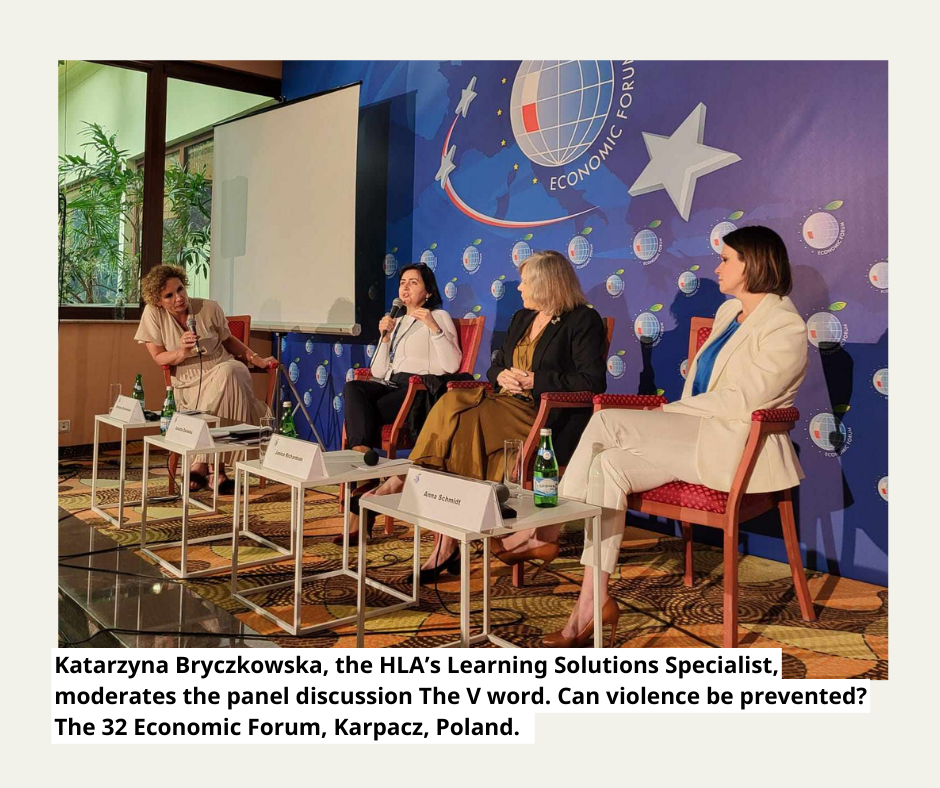10th October 2023
This is based on the HLA Eastern Europe Regional Team’s experience and the findings of the report by the LSE Department of International Development: Transformational Humanitarian Response: The Example of Poland commissioned by the Humanitarian Leadership Academy and Save the Children.
Read the full report in English and Polish on our website.
We are going to discuss transformational and localised humanitarian response and the findings of the report with Pawel Mania and Kamila Wujec.
About our experts

Pawel Mania, Deputy Director for Transformational Response.
Pawel has more than 15 years of experience working across the international development and humanitarian sectors. In his current role with HLA, he is accountable for impact, advocacy and strategic engagement to ensure quality delivery of the HLA’s humanitarian responses, including Ukraine Regional Response. Pawel is an expert in research, evaluation and strategic communication, having worked previously at the British Council and Committee on Foreign Affairs at the European Parliament across various research, Research, MEAL, policy and advocacy roles. He has directly supported humanitarian programming in Mozambique, Ethiopia, Pakistan, Syria, Türkiye, Poland and Ukraine.

Kamila Wujec, Regional Lead – Eastern Europe.
Kamila’s work is focused on whole systems consulting and leadership development as well as organisational capacity building. As the Regional Lead, Kamila delivers the HLA Centre’s mandate of supporting capacity building and capacity strengthening of local actors related to the Ukraine response, involving systemic change, digital content delivery, face-to-face training, remote training delivery, content production and coaching and mentoring. Before joining our team, Kamila worked across government and international development in Poland as a certified coach, trainer, and group dynamics consultant.
One of the key findings of the report, and something we often hear from local partners, is that effective cooperation and collaboration between local and international actors is still one of the biggest challenges. Why do you think that is? What are the obstacles to establishing constructive cooperation?
K.W.: One of the reasons for that struggle to establish cooperation, especially in the early stage of the response, is rooted in both culture and psychology. We could observe the lack of a widely acknowledged and recognised humanitarian culture code in Poland, including standards, norms and meaning that apply to the particular actions that ultimately form the aid system in the historically understood humanitarian system setting.
The challenge is that people cannot refer new terms to previous experiences. There are no guidelines on how to get things right. That requires decision-making with a limited understanding and foresight of where this might be heading.
That also applied to the notion of partnership and collaboration in a humanitarian setting, which was understood very differently by local and international organisations. In intercultural settings, people often do not have the same concept, even if they use the same word. It gets even more complicated when actors are not very confident in their command of English. A few of the national and local responders and support organisations have had any humanitarian experience before, especially on an international level. A lack of commonly shared understanding of sector-specific language made communication more challenging and sometimes caused misunderstanding.
In this case, there was a different understanding of the concept of partnership and collaboration. While the local actors interpreted these concepts through the filter of interpersonal relations, network collaboration, trust and communication, the international humanitarian actors saw accountability, implementation and risk avoidance as the most essential factors. Concepts and frameworks clashed with the need for trusting the local expertise and connection to the local community embedded in a high-speed environment.
Moreover, local actors reported that as they were not familiar with the procedures standard for the international humanitarian sector, following them was often overwhelming, and they found them demanding and frequently changing. The representatives of the INGOs were also rotating quite often, which made building trusting relationships difficult. The standardised ways of working were not helpful for local actors performing under immense stress, emotional drain and time pressure.
I believe we can learn a lot from this response. Some of the immediate lessons learnt are the need for longer contracts for surge staff in the beginning phase of a response (minimum 6-12 months), training for staff contracting implementing partners, training for local organisations on the introduction of the basic principles of a humanitarian response setting and the implications of collaborations with donor organisations, to create better accessibility to donor funding for smaller organisations and volunteer-based groups, and to ease the due diligence process.
P.M.: The report sheds some light on key challenges and obstacles, though it would require in-depth analysis for us to better understand this particular context.
Having supported a number of global responses, what I find both striking and disheartening is that the issues and challenges sound very familiar. Initially, it felt like a missed opportunity. Here we are, responding in a high-income country, with a high level of political and social support for the refugees, a very engaged and invested civil society, and yet it doesn’t seem like we have fully capitalised on that. As if all the lessons learned and thorough studies from across the globe haven’t been utilised, and the INGO sector went into a default mode.
However, reflecting more on this, and this report was very helpful here, I’m cautiously optimistic. I know first-hand that currently, most organisations have full-time local staff leading their work, very often coming from civil society or other local organisations, or at least very familiar with various local networks and interdependencies. This has reshaped the perception of the international sector as ‘other’ from the local perspective. I believe there is some collective understanding of the way forward as long as we enable further dialogue and share both ‘power’ and resources. We are all working for the common good, and the aid sector in Poland is still very small, so I’m very hopeful we can strengthen and improve this collaboration.
This is needed not only for the current response to the Ukrainian crisis but also for other current and future humanitarian needs, like the dire situation on the Belarussian border. The starting question should always be how we can collaborate most effectively (and including refugees themselves!) to ensure we achieve the desired impact for the affected populations. I love seeing Save the Children Poland, with the support of the Humanitarian Leadership Academy, enabling that dialogue.

Is the lack of trust in smaller, new, and/or not well-known organisations the reason? If so, how can these organisations raise their profile, get a positive reputation in the sector and achieve the mentioned mutual respect and equal partnership?
P.M.: It feels like the humanitarian system has been grappling with this dilemma for a very long time. The UN agencies and other key donors prefer to work with the usual suspects (i.e., INGOs) to avoid financial risks. The INGOs continue this path by funding national NGOs that are already established so they can identify some local partners that will lead on the implementation. However, I don’t think it’s just a matter of lack of trust. All actors need to work at speed and scale, so they chose a tested solution to minimise risks, as these are often the public funds we are talking about.
In Poland, this has been even more complex as apart from a few established relief organisations, the sector was totally unknown to the INGO world. Even though there might be justification to operate this way in an immediate response when there is not enough time for a strategic approach, this is not sustainable in a long-term perspective. Therefore, thorough but straightforward assessment must be considered from the get-go to provide relevant coaching and mentoring and other forms of capacity sharing. We see it coming up in every real-time review and evaluation across the Ukraine regional response, but also all the others I’ve read in the last few years from other responses.
The Humanitarian Leadership Academy has been supporting that transition for ten years now, which also includes preparing individuals and organisations before a crisis happens. But I dare to say, there has never been momentum quite like now. I think the whole sector realises this, and it’s also due to the Ukraine crisis. It’s not only about trusting local organisations but also one another to avoid any additional requirements from our local partners in terms of training, due diligence etc., so soon the funding can go directly to those closest to the response.
K.W.: The exclusion of smaller or informal organisations in the first six months of response is presumably rooted in the imperatives of administrating public and donor funding and meeting requirements to ensure accountability. The humanitarian sector distinguishes partnerships that include subgrant transfer, where donor funding will be administered by the local partner. Then, the international and local NGOs jointly implement a certain project to reach their joint objectives, which aim at other activities that do not require a transfer of funds.
The early stage of responses is typically the time when INGOs are looking for organisations that already have the capacity to absorb and administer donor funding to respond to the massive needs of the affected population. The mapping processes of potential partners are often conducted by staff who do not know the local context well and have to rely on recommendations and information available online and in coordination groups. Inevitably, only organisations that have worked professionally for decades and already have an institutional capacity, including established websites, a certain level of foreign language skills, etc., can be seen as reliable and able to comply with requirements.
However, we have seen clearly in this response that the current system excludes the driving force of this response, which is very context-specific. We have an impressively strong civil society movement consisting of informal community groups, individual volunteers and small entrepreneurs in both Poland and Ukraine. So far, the sector has failed to recognise this and adapt to the contextualisation.
But the opportunity is still there. The response is still active, and as the conflict unfolds, future scenarios in this part of the world are unknown. Senior decision-makers and sector leaders can still take steps towards change in the mindsets as well as in the rigorous system of public grant administration. For example, as required by local NGOs, it can be a common and unified due diligence process for local organisations, based on the systems they are used to, e.g., the Erasmus+ funding, in combination with a locally-led accreditation process, taking local law and realities of armed conflict into consideration. That would speed up humanitarian aid a lot.
Of course, over time, with the onboarding of national staff and better orientation in the ecosystem we operate in, even smaller organisations are recognised and acknowledged for their irreplaceable expertise. Yet, these are still rare examples as they usually do not stand for scale but for solutions to specific needs.
The involvement of the private sector in the refugee crisis response in Poland was unprecedented. Can you tell us about how humanitarian and private sectors can cooperate and if we have success stories from such cooperation?
K.W.: Indeed, the report articulates what we have observed across the country on a daily basis, e.g., transportation companies and catering services support, hotels transformed into shelter and housing, and various digital solutions helping the response. Although the report specifically showcases Poland’s response, there is evidence across the region, too.
To name a couple of examples: as a result of a joint Lublin response coalition, the city council in Lublin shared a building with their leading forces in civil society, e.g., the well-known Homo Faber Association, similarly, to Wroclaw city and their close collaboration with KOMM – a coalition of formal and nonformal groups of minority and migrant organisations. The collaboration between Ashoka Poland and Google jointly established pooled funding to support initiatives for refugees’ integration. Internationaler Bund in Krakow has entered a collaboration with Shell with the intention of developing a centre for education and support. Ikea is engaged with sector organisations to explore and support the professional integration of Ukrainian refugees into the labour market.
These excellent examples showcase that there is a huge space for the sector and business to enter jointly and potentially fill the gap of INGOs scaling down their funding or leaving the response. It also highlights the impact of cross-sector collaboration, which the HLA is especially committed to.
There is potential for more business sector collaboration, for example, through the establishment of strategic partnerships and a long-term commitment (ranging from 3-10 years), which allows both partners to achieve social and economic impact through focused and targeted solutions, ideally rooted in their region. Another area of win-win cooperation is corporate volunteering projects for impact, as well as the exchange of competencies and services, such as technological companies offering the humanitarian sector organisations their know-how, agile approach to tech solutions such as software, platforms, web design, and more. Consulting companies can offer management strategies and template solutions for large-scale operations.
In addition, the business sector can support the humanitarian response with flexible funding for projects that are far easier and faster to access and roll out, being able to decide freely on the priorities.
The humanitarian sector organisations are a safe space for refugee employment. However, they can lack long-term opportunities due to restricted funding periods, which are essential to refugees’ psychological safety and integration into society. Access to stable professional employment will remain at the forefront of the needs of refugees, to be able to be financially independent, psychologically safe, and able to create a stable situation for their own and their children’s integration. This is another area where local businesses can massively support the refugee crisis response.
P.M.: Just watching the crisis unfold, I was really inspired by how the whole Polish society engaged in supporting the refugees from Ukraine. This includes big and smaller local businesses that tried to play their part.
I found it both encouraging and disappointing that Polish local organisations preferred to collaborate with businesses rather than INGOs, but perhaps for different reasons than Kamila. I absolutely believe that the future of the humanitarian system needs to include businesses. The social and climate impact is more and more important for many businesses, as customers pay attention to that. Equally, public funds are becoming increasingly scarce, and the re-imagined humanitarian system must include all actors and their solutions. Organisations like Tech to Rescue are a great example of that.
However, what was more unsettling to read is that local organisations preferred to collaborate with businesses because our (INGOs’) systems are too complex and too slow. We can do better. The UK’s Disaster Emergency Committee is soon launching a pooled fund that will directly fund smaller organisations in Ukraine. This is led by Start Network, supported by HLA and soon a local host for the fund. The fund run by Ashoka in Poland is a great example of how such funds can be set up in partnership with the private sector.

The report raises rarely discussed issues such as burnout of volunteers and the rising anti-refugee sentiment. Have you witnessed this, and what are the ways to prevent this? Is burnout something the humanitarian response actors experience as well?
K.W.: Absolutely! Let’s not forget that we have just faced a global pandemic and are still recovering from its social aftermath.
The threat of burnout is real and is expressed explicitly as the response continues. Firstly, we have to be aware that local organisations are undertaking multiple tasks at the same time and are much more exposed to stress and overwork, which is rooted in the proximity to seeing people suffer. Moreover, local actors are often overwhelmed with the need to learn about the humanitarian sector and its principles, ways of working, and requirements, as well as to handle many stakeholder relationships and do continuous recruitment to hold on to the bureaucratic demand of the system. This is paired with the task of suddenly managing largely scaled-up organisations, continuing to respond to crises and being accountable to the groups they directly work with daily. But the scale of needs leaves no time to process this emotionally.
We have also witnessed the despair and helplessness of frontline humanitarian leaders.
Whilst the international funding opportunities shrink, the needs of the refugee population change and do not vanish.
To prevent burnout on both sides, a critical thing for international actors is the awareness and responsibility of being accountable in stakeholder relations and working on clear, transparent communication, giving local organisations credit and a clear foresight of timeframes, next steps, and outlining the whole process. A clear overview of how long and how time-consuming the process of assessment, proposals and contracting given the current resources of the INGO, including potential delays or negative decisions, is another key thing.
For local organisations, setting boundaries, knowing what they do or do not want to engage with, and a critical self-assessment of their capacity are crucial to prevent burnout and overwhelmingness.
But foremost, we must put effort into human relations and interpersonal connections. As one of my Ukrainian colleagues recently put it: “We survive because we support each other. Today I am helping somebody, and I will get help from somebody when I am in need.”
Another critical topic raised in the report is child protection. I would expand this to the prevention of human trafficking in general, as the majority of the refugees were women and children. Can you share your insights on this? Tell us about the HLA’s impact by providing safeguarding training in the region.
P.M.: I let Kamila explain more on this subject, but I want to emphasise that child protection still remains a big concern within the response in Poland. In May this year, Save the Children, together with the International Rescue Committee, called for an immediate stop to the return of children in institutional care centres from Poland to Ukraine with concerns around lack of coordination and planning putting children at further risk.
K.W.: Safeguarding is non-negotiable, that’s why the HLA always starts with this critical work first. Our regional team has trained over 500 local actors in Child Safeguarding so far, and this remains one of the top priorities.
One of the first things we approached was translations of the essential learning resources covering Safeguarding into local languages. All these resources are now available on our free online platform Kaya and the Response Learning Hub, and we actively promote them to our partners and across the response.
We also share expertise and capacity building within the Capacity Strengthening Task Force and collaborate and exchange experience with our partners, such as the Safeguarding Academy with the Safeguarding Response Hub, A21, and others.

In line with the recommendations of the LSE report, the HLA team in Poland contributes to the Ukraine refugee crisis response in alignment with the localisation agenda. HLA continues strengthening the capacity of local actors by providing essential and advanced learning opportunities, for example, in-person training and workshops on Education in Emergencies, Humanitarian Operations Programme, and webinars on such crucial topics as proposal writing and managing data in humanitarian response in Polish and Ukrainian.
